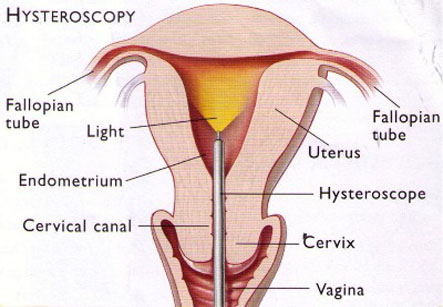Hysteroscopy
Introduction
Hysteroscopy is a procedure in gynecology that is performed to look inside the uterus for diagnosis and treatment of conditions causing abnormal bleeding. Hysteroscopy is done using a thin tube like instrument having a camera called as hysteroscope. It is inserted into the vagina to examine the cervix and inside of the uterus.
Indications
A hysteroscopy can be diagnostic or therapeutic.
Diagnostic:
1. To find the cause of severe cramping or abnormal bleeding.
2. To find the cause of infertility in uterus such as scar tissue or blocked tubal openings in uterus.
3. To diagnose congenital deformities in size and shape of uterus such as unicornuate uterus, uterus didelphis.
We have all the information you need about public and private clinics and hospitals that provide gynaecological treatment in Iran

4. For finding the cause of repeated abortions.
5. To find the misplaced intrauterine device.
6. Diagnosis of endometrial cancer by biopsy.
7. Small submucosal fibroids or polyps can be found.
Therapeutic:
1. To remove misplaced intrauterine device
2. To open the blocked ostia of the fallopian tubes by passing special instruments during hysteroscopy as a part of infertility treatment.
3. Benign lesions like polyps and fibroids can be resected.
4. Endometrial biopsy can be taken to rule out cancer, hypertrophy or causes of abnormal bleeding.
5. Endometrial ablation is a procedure to destroy the inner lining of uterus to treat some causes of heavy menses. Heat energy is used in this procedure.
6. Adhesions are bands of scar tissue formed in the uterus (also called as Asherman’s syndrome) which can lead to abnormal bleeding or infertility. These can be removed by hysteroscopy.
7. Uterine septum or other congenital malformations of uterus can be corrected by hysteroscopy.
8. A contraceptive implant can be inserted in the tubal opening along with other procedures.
Before the procedure:
1. Hysteroscopy is usually performed during the first week after the period (day 5-12 of cycle).
2. If fibroid removal needs to be done, medications for shrinkage of the fibroid should be taken for a few weeks before surgery.
3. Doctor should be informed if the patient may be pregnant.
4. Also it should be informed about whether the patient is taking any blood thinning agents like aspirin, have any heart or lung disease, history of recent vaginal or pelvic infection, and allergy to any medications.
5. Discussion about the procedure and its risks should be done with the treating doctor beforehand. Possible results also need discussion.
6. A consent form should be signed before the surgery.
7. Patient should not eat or drink after midnight the day before surgery.
Procedure:
The procedure is usually done under general anesthesia. But regional anesthesia with sedation can be given.
1. A hysteroscopy is usually done by the gynecologist in the operating room of a hospital.
2. It takes about 30 minutes for entire surgery if no other therapeutic intervention is required.
3. The procedure is started after the patient empties the bladder and changes into surgical gown. The position of surgery is lying on back with feet raised and supported by footrests.
4. An instrument with smooth, curved blade known as speculum is inserted in the vagina to spread apart the vaginal walls gently.
5. The hysteroscope is inserted in vagina and gently manipulated in uterus through cervix. A gas or liquid is insufflated in the uterus for better view of uterine mucosa.
6. Hysteroscope gives a magnified view of inner uterus and it can be connected to a video monitor.
7. The interior is examined meticulously for finding the suspected cause of patient’s symptoms. If any procedure needs to be done, it is performed by small instruments with guidance of the video monitor.
Recovery:
1. The patient is taken to recovery room and monitored for at least half an hour.
2. Abdominal cramping can occur after the procedure and can be relieved by medications.
3. A bloody discharge is normal for a few days after surgery.
4. Sanitary napkins should be used and not the tampons.
5. Sexual intercourse and strenuous physical activity should be avoided for at least two weeks.
6. Patient can resume normal activities within 24 hours after surgery.
Complications:
1. Uterine bleeding
2. Injury to uterus or cervix
3. Rarely, puncture of bowel or bladder. This requires urgent surgery.
4. Air embolism
5. Infection
6. The fluids injected to distend the uterus for having clear view can be absorbed in blood. This leads to lowering of sodium levels which is hazardous and needs urgent correction.
7. Anesthesia related problems.